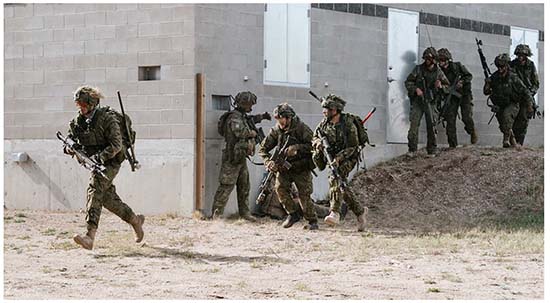State-of-the-art urban warfare training arrives for Canadian Armed Forces
March 23, 2022 - Defence Stories

Caption
Canadian Army Soldiers secure a village during Exercise Maple Resolve 21 at the 3rd Canadian Division Support Base Detachment Wainwright training area.
Photo: Corporal Djalma Vuong-De Ramos, Canadian Armed Forces Photo
Realistic, challenging, and regular training is critical to ensure that Canadian Armed Forces (CAF) members can succeed on operations in any environment, and under any condition. Through investments in state-of-the-art training facilities, the Government of Canada is ensuring that CAF members remain prepared to meet modern operational challenges, including increased operations in urban areas – a priority under Canada’s defence policy, Strong, Secure, Engaged.
As of August 2021, the CAF now has four new and fully operational simulated urban training sites at:
- 5th Canadian Division Support Base (5 CDSB) Gagetown
- 2nd CDSB Valcartier
- 4th CDSB Petawawa
- 3rd CDSB Detachment Wainwright
By combining live simulation hardware and software, with advanced structures, and other interactive components these sites provide an enhanced urban training capability for Canadian Army teams, that imitates the conditions and challenges a soldier may experience during urban warfare conditions.
Depending on the training scenario, simulated effects may include the sound of artillery fire, the smell of explosives, or the flash of a detonation, as well as pop-up targets, simulated aerial attacks or building blackouts. This new urban equipment is integrated with the Weapons Effect Simulation system currently in-service, providing soldiers with a fully immersive and realistic training environment.
These systems have been delivered as part of the Urban Operations Training Systems (UOTS) project.
The UOTS consists of a cluster of buildings that are equipped with high-fidelity tracking systems, indoor and outdoor cameras, speakers, microphones, infrared illumination, magnetically-controlled breachable doors, and simulated weapons including pop-up targets, Improvised Explosive Devices (IED), traceable grenades, and smoke and odor generators.
System operators can monitor soldier movements and actions via 2D & 3D mapping, microphones, and cameras during exercises, and can introduce simulated effects as required. Live exercises can also be recorded and reviewed to improve soldier performance during after-action reviews.
Training will be conducted year-round. Each site has between four and 23 training buildings, and can support teams of at least 250 soldiers. The largest site (3 CDSB Detachment Wainwright) is able to support up to 1,500 soldiers for collective training.
Video - Urban Operations Training System